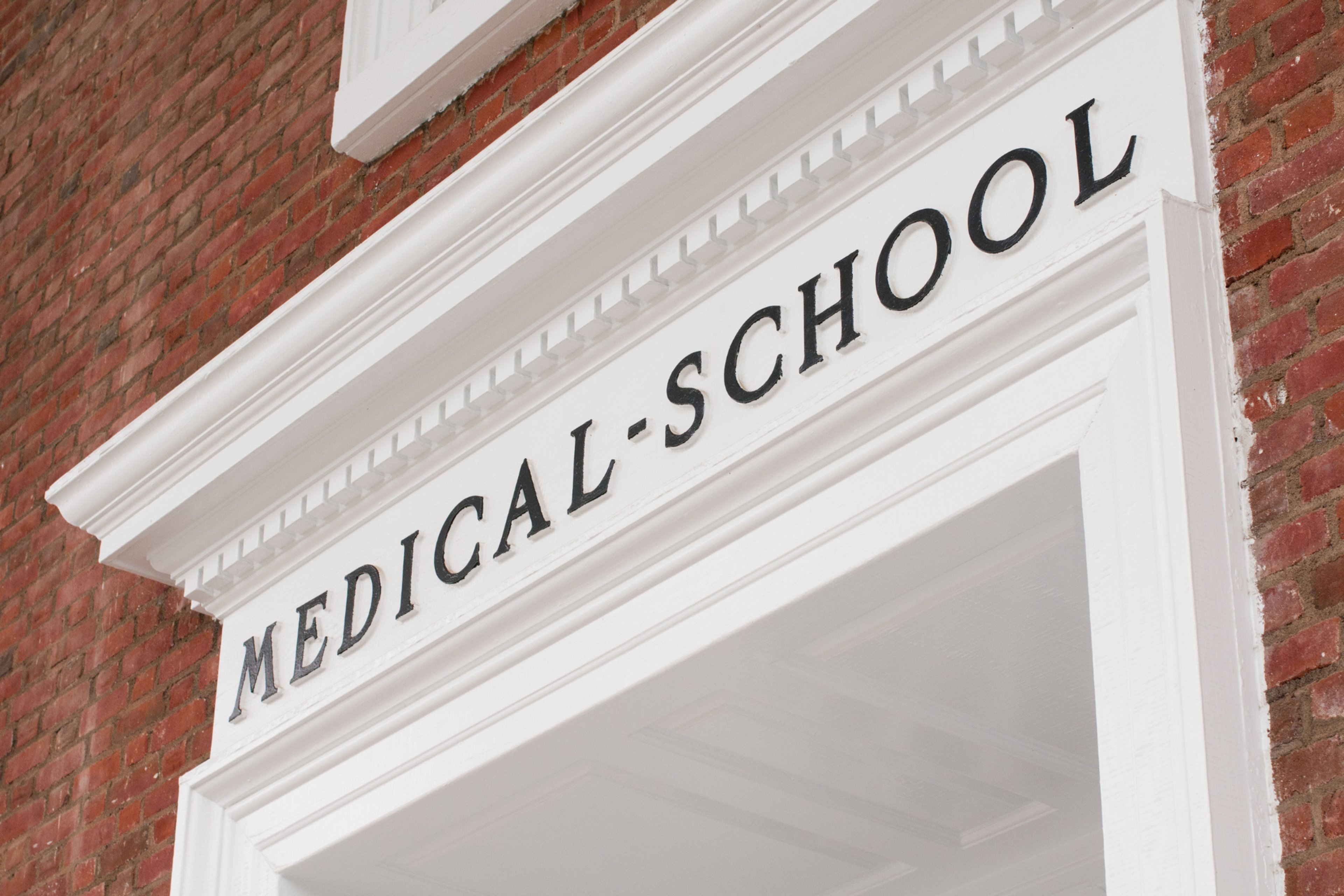The 10 Best Medical Schools in California
Explore the top 10 medical schools in California with admissions stats, program highlights, and expert tips to help you find your best-fit school.
Posted April 8, 2025

Table of Contents
California is home to some of the most competitive medical schools in the country. With high-ranking programs, strong research funding, and a diverse patient population, it's no surprise that many medical students aim to attend school here. But applying to medical schools in California means understanding more than just rankings. It means knowing what each program values, how competitive they are, and how to improve your chances.
This guide breaks down all 10 medical schools in California, including admissions stats, degree types, regional placement, and key strategies for getting in. Whether you're focused on primary care, research, or underserved communities, there's a program in California that may fit your goals.
What is Medical Education?
Medical education encompasses the rigorous training and instruction required to become a licensed physician. It involves a comprehensive understanding of human anatomy, physiology, pathology, and the application of this knowledge in diagnosing and treating illnesses. Medical education also emphasizes the development of clinical skills, ethical practices, and patient-centered care.
Why is Medical Education Important?
Medical education is crucial as it ensures that future physicians are well-equipped with the knowledge and skills necessary to provide high-quality healthcare. It fosters critical thinking, continuous learning, and adaptability in an ever-evolving medical landscape. Moreover, it instills a commitment to ethical practice and compassionate patient care.
Key Components of Medical Education
- Pre-Clinical Training: Focuses on foundational medical sciences and laboratory work.
- Clinical Training: Involves hands-on patient care experiences in various medical specialties.
- Residency: Post-graduate training in a chosen specialty, leading to board certification.
- Continuing Medical Education (CME): Ongoing learning to stay updated with medical advancements.
Examples of Medical Education Pathways
- Allopathic Medicine (MD): Traditional medical degree focusing on diagnosis and treatment through various modalities.
- Osteopathic Medicine (DO): Emphasizes a holistic approach, including osteopathic manipulative treatment.
- Dual Degrees (MD/PhD, MD/MPH): Combines medical education with research or public health training.
Overview of Medical Schools in California
Out of the 13 MD programs, 6 belong to the University of California system, offering reduced tuition for in-state residents. Most public California medical schools give strong preference to in-state applicants, while private schools admit more out-of-state students.
Despite the high number of schools, acceptance rates are extremely competitive due to the volume of applications and limited spots, especially at the best medical schools like Stanford University School of Medicine and UCSF School of Medicine.
There are 16 medical schools in California:
- 13 allopathic (MD-granting)
- 3 osteopathic (DO-granting)
How to Choose a California Medical School
1. In-State vs. Out-of-State Preference
Public UC medical schools (like UC Davis, UC San Diego, UC Riverside, and UC Irvine) heavily favor California residents. If you’re out-of-state, your chances at these schools are significantly lower unless you have strong ties to the state or match a high-priority mission (e.g., underserved care). Private schools like Stanford, USC Keck, Loma Linda, and California Northstate don’t have a stated in-state preference, making them more accessible to out-of-state applicants—but also more competitive across the board.
- UC Riverside admits almost exclusively in-state applicants, with nearly 99% of seats going to Californians.
- UC Davis prioritizes applicants from Northern California and rural or agricultural backgrounds.
2. Mission Fit and Institutional Priorities
Every medical school has a specific mission that influences its admissions process. If your personal background and career goals align with the school’s mission, your application is stronger.
- Primary care focus: UC Davis, UC Riverside, Touro, and WesternU train students to serve local communities, especially in underserved or rural areas.
- Research-oriented: Stanford, UCSF, and UCLA seek applicants with strong research experience and publication history.
- Social justice and community health: Drew, CUSM, and Kaiser prioritize applicants who want to improve healthcare access for historically excluded groups.
- Religious and values-based: Loma Linda integrates Christian values and holistic care into its curriculum.
Note: Read each school’s mission statement, admissions page, and program details. Then use that information to tailor your secondary essays and interview responses.
3. GPA and MCAT Expectations
Admissions statistics vary widely across California schools. Some programs require top-tier academics, while others are more flexible but still selective.
- For most MD programs, you’ll need a GPA above 3.7 and an MCAT of 510 or higher.
- DO schools are slightly more flexible, but still expect strong academic performance and a clear commitment to osteopathic medicine.
Tip: Use tools like MSAR and Choose DO Explorer to compare your stats with school medians before finalizing your school list.
4. Location and Clinical Rotation Sites
Where you train can shape your residency options, patient exposure, and long-term career preferences. If you plan to stay in California long term, choosing a school with clinical sites in your preferred region can help with residency matching and network building.
- Urban hospitals: Keck (Los Angeles General), UCSF (San Francisco General), and UCLA offer high patient diversity and complex care environments.
- Community clinics: UC Riverside, Touro, and Drew rotate students through underserved, community-based clinics.
- Teaching hospitals: Stanford, UCSF, and UC San Diego are tied to major academic research centers with residency programs and NIH funding.
- Regional focus: Some schools, like California University of Science and Medicine, serve the Inland Empire and partner with Arrowhead Regional Medical Center.
5. Secondary Essays and Application Volume
Secondary applications vary significantly in time and effort. Be strategic with your school list based on how much time you can realistically commit. Some prompts require 800+ words per response. Others limit you to 300 characters. Start a spreadsheet to track essay prompts, deadlines, and lengths so you can manage your time and submit quality responses.
- UCLA: 6 essays + additional pathway questions
- Stanford: 8 essays + 1 optional
- UC Davis: 3 required + pathway questions
- Loma Linda: 8 required + religious fit questions
6. Tuition, Scholarships, and Cost of Attendance
Tuition in California varies widely depending on whether the school is public or private—and whether you're in-state. Be sure to check each school’s scholarship page, FAFSA requirements, and cost of attendance calculators to plan your finances early.
| School Type | In-State Tuition (Annual) | Notes |
|---|---|---|
| UC Schools | ~$44,000–$52,000 | Out-of-state tuition is ~$10,000–$15,000 higher |
| Private Schools | $70,000+ | Financial aid varies; often less predictable |
| Kaiser | $0 | Full tuition is covered through 2025 (merit-based after that) |
- Kaiser Permanente School of Medicine offers full scholarships to all students through its first six entering classes.
- DO schools like Touro and WesternU are private and carry tuition similar to MD programs but may have different financial aid models.
- Factor in cost of living—schools in Los Angeles, San Francisco, and San Diego have higher housing and living costs.
List of Medical Schools in California (2025)

1. UCSF School of Medicine (San Francisco)
- Graduates Practicing in Primary Care: 49%
- Applicants: 9,090
- Interviews Offered: 544
- Class Size: 167
- Acceptance Rate: 1.8%
- Median GPA: 3.87
- Median MCAT: 90th percentile (about 515)
- CA Residents: 71%
- Underrepresented in Medicine: 54%
- Female Students: 57%
Learn About the Entering Class of 2022
Example Courses:
- Foundations of Patient Care
- Health & the Individual
- Disease Mechanisms & Therapeutics
- Clinical Microsystems Clerkship
- Career Launch (Subinternships & Residency Prep)
UCSF School of Medicine is consistently ranked among the top medical schools in the U.S. for both research and primary care, earning Tier 1 status in both categories according to U.S. News & World Report. Its flagship Bridges Curriculum integrates early clinical exposure, systems improvement, and inquiry-based learning to help students become compassionate, evidence-driven physicians from the start. UCSF delivers a mission-driven education with a strong emphasis on health equity, underserved care, and interprofessional teamwork, offering clinical training at high-volume public institutions like Zuckerberg San Francisco General Hospital and the SFVA. Programs like PRIME-US further support students committed to serving urban, marginalized communities. With one of the nation’s highest NIH funding levels, six Nobel Laureates on faculty, and cutting-edge work in genetics, neuroscience, and cancer care, UCSF is a powerhouse of biomedical innovation that prepares graduates to lead in academic medicine, public health, and beyond.

2. Stanford University School of Medicine
- Graduates Practicing in Primary Care: 36.8%
- Applicants: 8,837
- Interviews Offered: 498
- Class Size: 89
- Acceptance Rate: 1.0%
- Median GPA: 3.89
- Median MCAT: 518 (25th–75th percentile: 515–521)
- Underrepresented in Medicine: 27%
- Female Students: 50.6%
- International Students: 9%
Visit Stanford University School of Medicine Facts & Figures
Example Courses:
- Practice of Medicine
- Health Disparities & Advocacy
- Foundations of Clinical Reasoning
- Scholarly Concentration Research
- Science of Medicine: Hematology, Immunology, Microbiology
Stanford University School of Medicine is one of the most selective and prestigious medical schools in the country, known for its emphasis on biomedical innovation, interdisciplinary collaboration, and flexible academic paths. The Discovery Curriculum allows students to customize their schedules to engage deeply in research or pursue dual degrees like MD/PhD or MD/MPH. Stanford’s robust training network includes rotations at five major clinical sites, providing early and diverse patient exposure. With 9 Nobel Laureates, 56 National Academy of Medicine faculty, and over $980 million in annual research funding, Stanford leads in translational science and medical breakthroughs. Students benefit from the school’s unparalleled proximity to Silicon Valley, exceptional mentorship, and need-based financial aid, graduating with one of the lowest average debt loads among private med schools. Whether you're aiming for physician-scientist training or global medical leadership, Stanford offers the resources and academic freedom to make it happen.
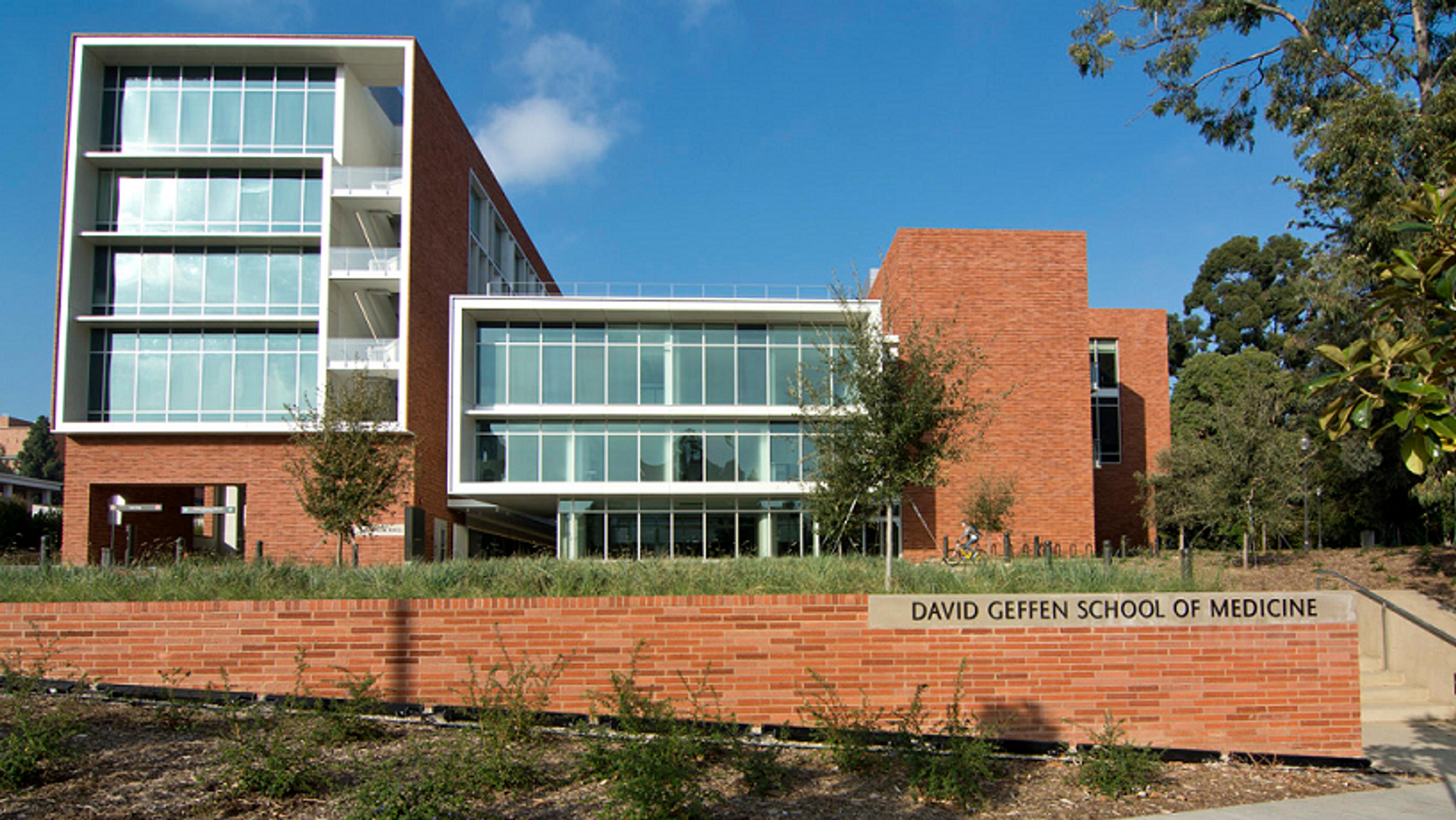
3. David Geffen School of Medicine at UCLA
- UCLA Medical School Acceptance Rate: 2.4%
- Women: 56%
- Underrepresented Minorities: 30%
- In-State Residents: 15%
- Median GPA: 3.96
- Median MCAT Score: 522
- Number of Applicants: 13,101
- Number of Interviews: 945 (7.2%)
- Class Size: 181
Visit the UCLA Applicants Medical School Admission Data
Example Courses:
- Foundations of Practice
- Human Biology & Disease
- Doctoring (Longitudinal Clinical Skills)
- Urban Health Equity Pathway
- Global Health Equity Pathway
The David Geffen School of Medicine at UCLA is one of the most prestigious public medical schools in the U.S., combining academic rigor with a deep commitment to underserved communities and health equity. Set in the heart of Los Angeles—one of the most diverse cities in the world—DGSOM offers its students unmatched clinical exposure through UCLA Health and public hospitals across Southern California. The newly redesigned curriculum blends active learning with early clinical immersion, while programs like PRIME-LA and the Urban Health Equity Pathway support students interested in addressing health disparities through leadership and advocacy. Dual-degree options, such as MD/MPH and MD/MBA, as well as the MSTP (MD/PhD), provide flexibility for students pursuing careers in research, policy, or administration. With generous financial aid programs, exceptional Match outcomes, and sunny LA as your campus, UCLA is an ideal launchpad for aspiring physician-leaders seeking to make a broad societal impact.

4. UC San Diego School of Medicine
- Applicants: 9,267
- Interviews Offered: 979
- Class Size: 152
- Acceptance Rate: ~1.6%
- Median GPA: 3.81
- Median MCAT: 514.1
- CA Residents: 77%
- Underrepresented in Medicine: 32%
- First-Generation College Students: 22%
- Female Students: Data not publicly specified for 2024
Visit the UCSD School of Medicine By the Numbers
Example Courses:
- Foundations of Medicine
- Clinical Foundations
- Core Clerkships
- Career Launch & Specialization Phase
- Health Equity & Social Justice Electives
UC San Diego School of Medicine ranks among the top medical schools nationally for both research and NIH funding, placing #4 among public institutions in 2023. Its C.O.A.S.T. (Clinical, Organizational, Academic Skills and Training) curriculum blends scientific rigor with early clinical experience and health equity initiatives. UCSD is also known for fostering innovation through a vibrant research environment and direct ties to the region’s booming biotech sector. Students rotate through major hospitals across San Diego County, including UCSD Medical Center and Rady Children’s Hospital. A strong emphasis is placed on diversity, social responsibility, and community-centered care. With its oceanfront location, commitment to scientific discovery, and a student body that includes artists, first-generation scholars, and even former lifeguards and nuclear engineers, UC San Diego cultivates both competence and compassion in its future physicians.
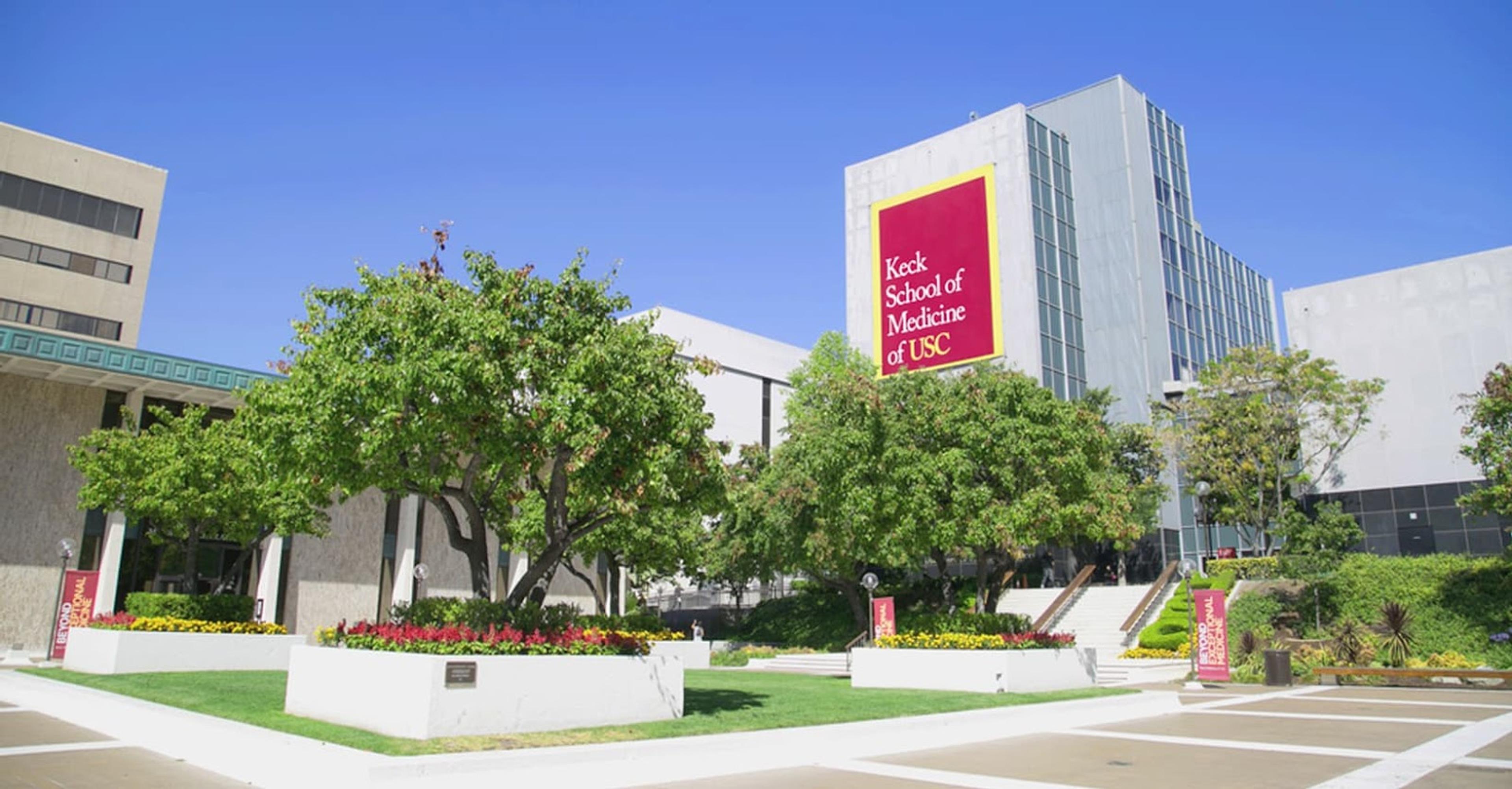
5. Keck School of Medicine of USC
- Applicants: 8,181
- Interviews Offered: 577
- Class Size: 186
- Acceptance Rate: 2.3%
- Median GPA: 3.85
- Median MCAT: 517
- Female Students: 53%
- Underrepresented in Medicine: 30%
- Top Majors: Neuroscience, Biology, Human Biology
Visit the Keck School of Medicine of USC MD Program Class of 2028
Example Courses / Experiences:
- Foundations of Clinical Medicine
- Integrated Case-Based Learning
- Health Justice & Advocacy Curriculum
- USC Street Medicine Clinical Rotation
- Human Behavior in Medicine
The Keck School of Medicine of USC prepares students to lead with purpose through a dynamic curriculum rooted in innovation, equity, and impact. With top-tier NIH funding per faculty investigator and strong clinical partnerships—including Keck Medical Center, CHLA, and L.A. General—students gain robust training across diverse patient populations. Keck emphasizes early clinical immersion, health equity, and interdisciplinary learning. Signature programs like USC Street Medicine and a wide range of dual-degree options (MD/MPH, MD/PhD, MD/MBA) reflect Keck’s commitment to producing physicians who are both skilled and socially conscious. From groundbreaking research in Alzheimer’s and AI to bold community partnerships, Keck nurtures leaders ready to transform the future of health.
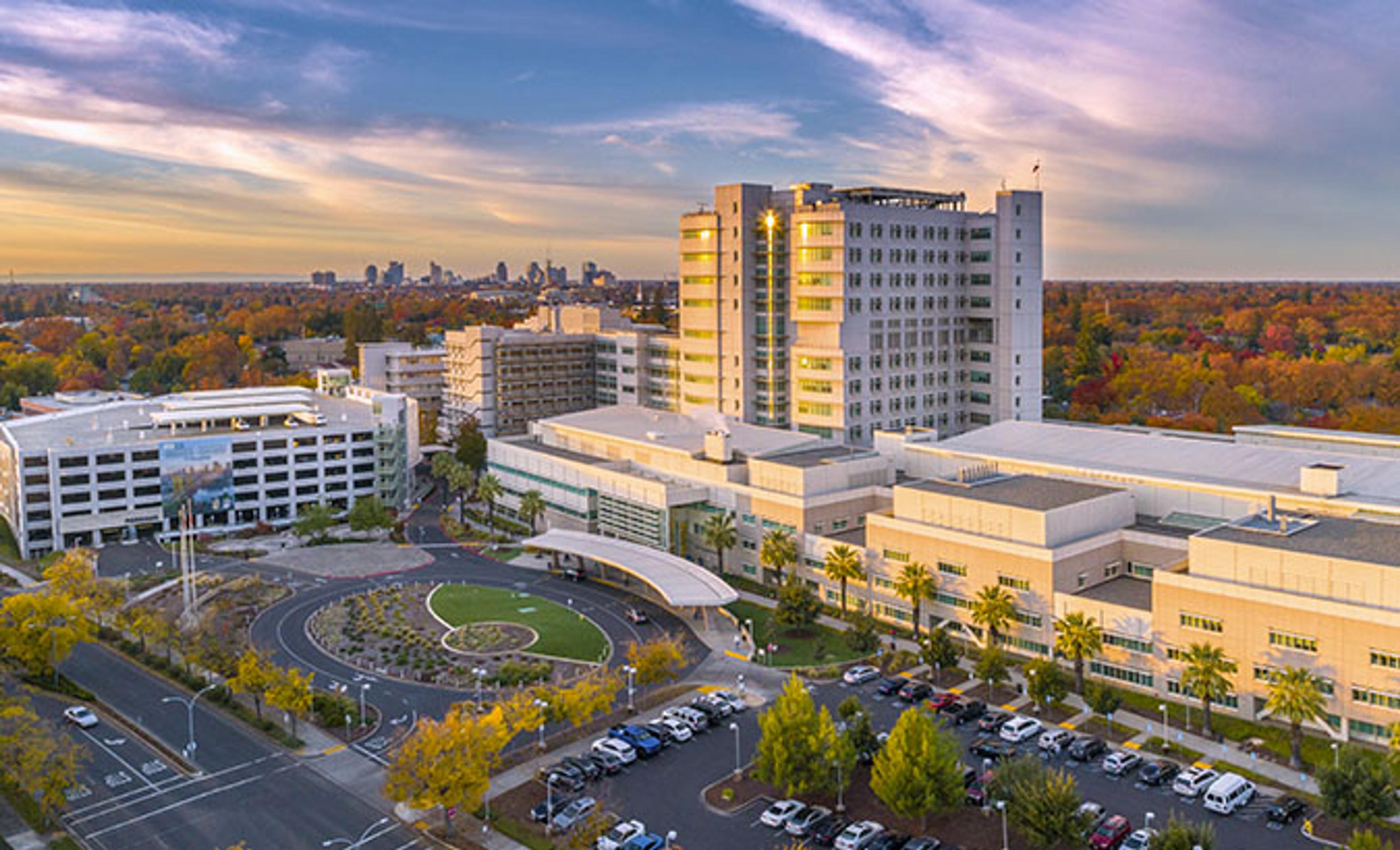
6. UC Davis School of Medicine
- Applicants: 9,267
- Interviews Offered: 979
- Class Size: 137
- Acceptance Rate: ~1.5%
- Median GPA: 3.73
- Median Science GPA: 3.50
- Median MCAT: 509
- MCAT Percentile: 73%
- Female Students: 57.7%
- Male Students: 32.1%
- Genderqueer/Another Identity: 3.6%
- First-Generation College Students: 39.4%
- Disadvantaged Background: 70.1%
- Underrepresented in Medicine: 30%
- Top Feeder Institutions: UC system (66.4%), CSU (9.5%), Private/Out-of-State (24.1%)
- Top Majors: Biological Sciences, Psychology, Philosophy, Spanish, Visual Arts
Visit the UC Davis School of Medicine Class of 2027
Example Courses / Experiences:
- Doctoring & Clinical Skills
- I-EXPLORE Curriculum (Health Systems Science & Evidence-Based Medicine)
- Student-Run Clinics
- AvenueM Pre-Med Pathway
- Health Equity Academy
- Rural-PRIME & TEACH-MS Tracks
UC Davis School of Medicine is nationally recognized for its commitment to health equity, community service, and innovative education tailored to underserved populations. As the only academic medical center in inland Northern California, it offers unmatched opportunities for clinical training in diverse settings—from student-run clinics to rural health initiatives like Rural-PRIME. With strong support services, personalized coaching, and robust pipeline programs such as AvenueM, UC Davis cultivates a future physician workforce grounded in social mission and service. Whether you're interested in public health, policy, or primary care, UC Davis prepares students to lead change and improve care for vulnerable communities across the state.

7. UC Irvine School of Medicine
- Applicants: 6,929
- Secondaries Submitted: 4,131
- Interviews Offered: 491
- Accepted: 273
- Class Size: 114
- Acceptance Rate: ~3.9%
- Median Cumulative GPA: 3.94
- Median Science GPA (BCPM): 3.89
- Median MCAT: 516
- Female Students: 68%
- Male Students: 31%
- Other Gender Identities: 1%
- Underrepresented Minorities: 33%
- Underrepresented in Medicine: 26%
- Top Feeder Schools: UCLA (25), UCI (14), UCSD (8), UC Berkeley (7), UCSB (5)
- MD Pathways: MD Only (91), MSTP (5), PRIME LEAD-ABC (10), PRIME-LC (6), MSTP/PRIME-LC (1)
Visit the UCI School of Medicine By the Numbers
Example Courses / Programs:
- Foundations of Clinical Practice
- Doctoring and Clinical Skills
- PRIME-LC (Latino Community Health Track)
- LEAD-ABC (African, Black, Caribbean Health Track)
- HEAL-IM (Integrative Medicine Track)
- Interprofessional Education & Culinary Medicine
- Global Health and Innovation Electives
UC Irvine School of Medicine is a mission-driven institution dedicated to serving underserved and underrepresented populations across California. With a highly selective admissions process and a holistic review of applicants, UCI emphasizes community service, cultural competency, and leadership. Programs like PRIME-LC and LEAD-ABC provide targeted training for future doctors passionate about advancing health equity for the Latino and Black communities, respectively. The school offers rich clinical exposure through UCI Medical Center and other community partnerships and integrates cutting-edge research, innovation, and personalized learning tracks into its MD curriculum. UCI is an ideal place for future physician-leaders ready to tackle health disparities through service, science, and education.

8. UC Riverside School of Medicine
- Applicants: 6,464
- Class Size: 87
- Acceptance Rate: ~1.35%
- Average MCAT: 508
- Average BCPM GPA: 3.60
- Age Range: 20–43
- Female Students: 45%
- Male Students: 44%
- Another Gender Identity: 11%
- Underrepresented in Medicine: 53%
- First-Gen College Students: 41%
- Economically Disadvantaged: 43%
- English as a Second Language: 32%
- Grew Up in a Medically Underserved Area: 63%
- Strong Ties to Inland Southern California: 80%
Visit the UC Riverside School of Medicine Class of 2028 Profile
Example Courses / Programs:
- Thomas Haider Program in Biomedical Sciences
- Clinical Skills & Simulation Center
- FastStart Summer Bridge Program
- Postbaccalaureate Premedical Program
- UCR Street Medicine
- Community Health Pathways
- Master of Public Health (MPH)
- MS/PhD in Biomedical Sciences
UC Riverside School of Medicine is California’s first new public medical school in over 40 years, founded in 2013 with a strong mission to serve the Inland Southern California region. The school is deeply community-oriented, selecting applicants with a demonstrated commitment to underserved populations and addressing regional physician shortages. UCR’s small class size fosters personalized learning, and over 80% of students have ties to the local area. Signature programs like the Haider Program and a focus on medical education for first-generation and disadvantaged students position UCR SOM as a leader in equitable medical training. With strong community partnerships, diverse pathway programs, and a deep commitment to health equity, UCR prepares future physicians to make a lasting impact both locally and globally.

9. Kaiser Permanente School of Medicine
- Applicants: 7,731
- Class Size: ~50
- Acceptance Rate: ~0.65%
- Median MCAT: 517
- Median GPA: 3.70
- Average Age: 24
- Female Students: 48%
- Male Students: 50%
- Genderqueer/Nonbinary: 2%
- Underrepresented in Medicine: 44%
- First-Gen College Students: 26%
- Socioeconomically Disadvantaged: 40%
- Nontraditional Students: 32%
- LGBTQ+ Identifying: 30%
Visit the Kaiser Permanente School of Medicine Class of 2023 Profile
Example Courses / Programs:
- Integrated Spiral Curriculum
- Early Clinical Immersion
- Simulation Center
- Anatomy Beyond Cadavers
- MD-PhD Program
- Service-Learning and Community Engagement
- Residency Preparedness Program
- Focused Advising and Mentorship
Kaiser Permanente Bernard J. Tyson School of Medicine (KPSOM) is a forward-thinking, equity-driven institution offering full-tuition scholarships to all students through the Class of 2026. Located in Pasadena, KPSOM combines early clinical experience with an integrated, case-based curriculum that emphasizes population health, health systems science, and patient-centered care. Students learn in small-group settings with access to cutting-edge facilities like the Simulation and Anatomy Resource Centers. With a strong mission to improve health equity and serve underserved communities, KPSOM trains future physicians who are as committed to advocacy and innovation as they are to clinical excellence.
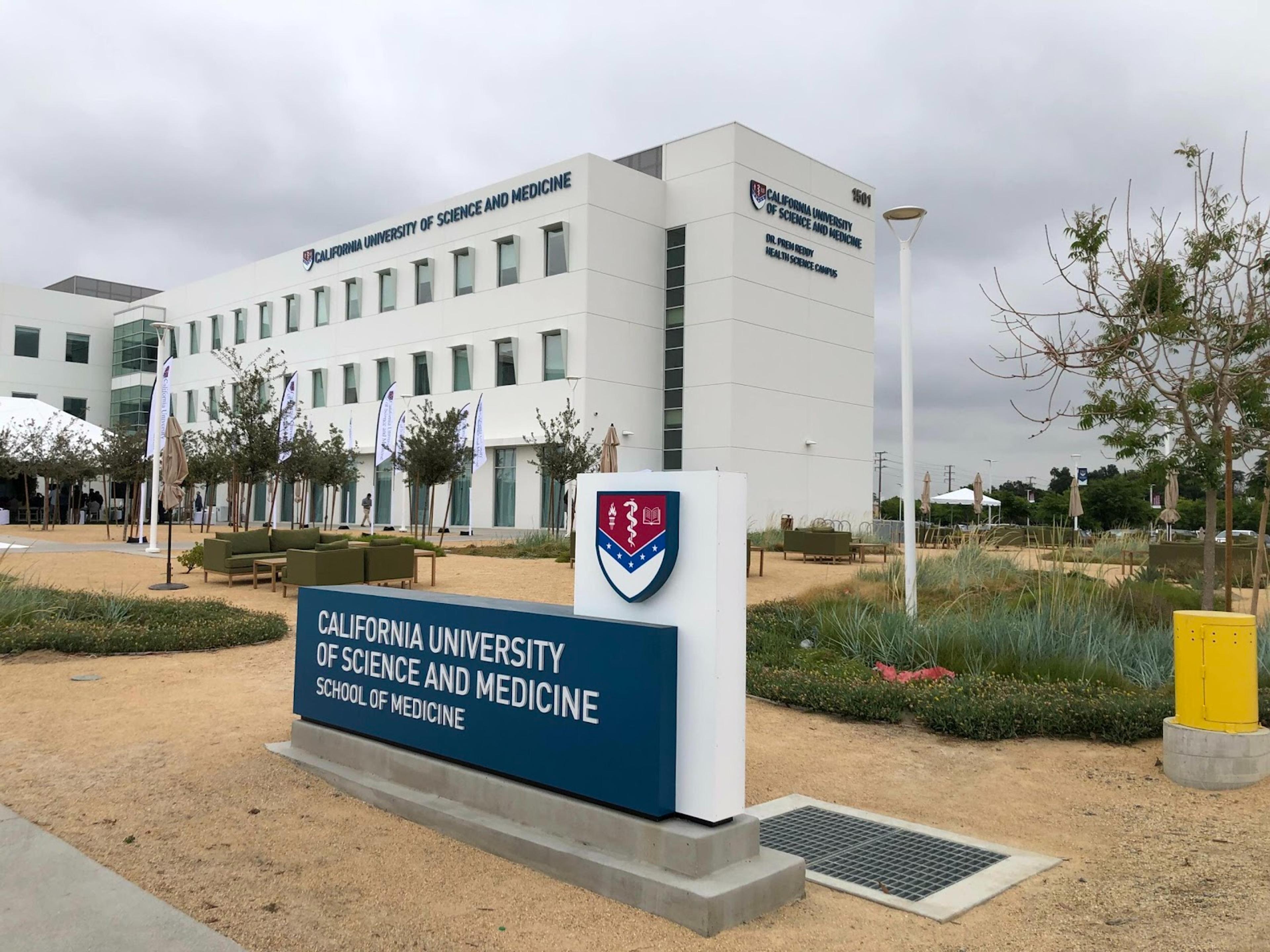
10. California University of Science and Medicine
- Applicants: Not publicly disclosed
- Class Size: 113
- Acceptance Rate: Not available
- Average MCAT: 511
- Minimum MCAT Considered: 502
- Preferred GPA: 3.0+ (Total and BCPM)
- Female Students: Not disclosed
- Male Students: Not disclosed
- Average Age: Not disclosed
- Underrepresented in Medicine: Not disclosed
- Primary Care Matches: 39%
- Workforce Shortage Area Matches: 52%
- Match Rate: 100% (2024)
- Inland Empire Matches: 34%
- Students from California: 81%
- Out-of-State Students: 19%
Visit the CUSM 2024 MD Program Outcomes
Example Courses / Programs:
- Doctor of Medicine (MD) Program
- Master of Biomedical Sciences (MBS) Program
- Postbaccalaureate Pathways
- Clinical Skills and Simulation
- Primary Care and Shortage Area Focus
- Community Health Pipeline Initiatives
- Integrated MD Curriculum
- ACGME Competency-Based Training
The California University of Science and Medicine (CUSM), located in Colton, is one of California’s newest private medical schools, founded with a mission to improve healthcare access in the Inland Empire. CUSM takes a service-oriented, equity-focused approach by preparing students to address physician shortages and serve medically underserved communities. With 52% of graduates entering shortage-area specialties and 34% staying in the Inland Empire for residency, CUSM’s impact is both local and long-lasting. The school boasts a 100% residency match rate and an integrated, competency-based curriculum grounded in ACGME’s six core principles. Through its MD and MBS programs, CUSM continues to build a future physician workforce rooted in compassion, excellence, and community engagement.
Other Medical Schools in California
- California Northstate University College of Medicine: Based in Elk Grove, California Northstate is privately funded and newer. It has faced some scrutiny for its accreditation history and lack of federal financial aid access in its early years.
- Loma Linda University School of Medicine: A faith-based institution tied to the Seventh-day Adventist Church. Promotes whole-person care and service. Students take religion courses and must follow a lifestyle code but receive a full LCME-accredited medical education.
- Charles R. Drew University of Medicine: A historically Black institution focused on addressing health disparities. Offers a small, mission-driven program with an emphasis on serving underserved communities in Los Angeles.
- Touro University California (DO): Located in Vallejo, this College of Osteopathic Medicine offers a primary care–oriented education and programs like the Student-Run Free Clinic and Global Health Initiative.
- Western University of Health Sciences (DO): Based in Pomona, Western is one of the most established osteopathic medical schools in California. Offers strong interprofessional education and early clinical experience.
- California Health Sciences University (DO): Located in Clovis, CHSU is a newer school serving the Central Valley. Focuses on team-based learning and aims to train physicians to stay in local, underserved communities.
5 Expert Tips for Choosing the Right Medical School in California
1. Choose Schools That Align with Your Mission
Don’t just chase rankings—apply where your goals fit the school’s mission. UC Riverside, UC Davis, and Kaiser prioritize students passionate about community health and underserved populations. If research is your focus, Stanford, UCSF, and UCLA are stronger fits. Read each school’s mission and programs, then reflect that alignment in your secondaries and interviews.
2. Be Strategic About Stats
California schools are competitive, but their expectations vary. A 508 MCAT might be a stretch for Stanford but right on target for UC Riverside or CUSM. Use class profiles to see where you stand. If your GPA or MCAT isn’t top-tier, highlight your community service, leadership, or resilience to stand out in holistic reviews.
3. Think Long-Term About Location
Where you study often influences where you practice. Schools like UCR and CUSM have strong regional ties to the Inland Empire. UCSF, Stanford, and UCLA offer broader networks across California and beyond. If staying local matters, choose a program with strong residency placement in your desired region.
4. Factor in the Cost of Living
Tuition is just part of the picture—living in cities like LA or San Francisco adds significant cost. UC schools offer better rates for in-state students. Kaiser covers tuition through 2026. Always check scholarship options, debt averages, and the total cost of attendance before deciding where to apply.
5. Look at Curriculum and Support
Every med school teaches differently. Some focus on small-group learning (like Kaiser and UC Irvine), while others emphasize early research and clinical immersion (like Stanford and UCSF). Just as important is student support—advising, wellness, and mentorship. Choose a school with a learning style and culture that fits you.
Bottom Line
Choosing the right medical school in California isn’t just about prestige—it’s about finding the best fit for your goals, values, and learning style. Whether you're drawn to community-based training at UC Riverside, cutting-edge research at Stanford, or equity-driven innovation at Kaiser, California offers a range of programs to match your path. Pay close attention to mission alignment, admissions data, clinical opportunities, and long-term affordability. The most rewarding choice will be the one that not only supports your academic growth but also prepares you to serve the communities and causes you care most about.
Get Help From a Medical School Coach
Working with an expert coach can improve your chances of getting accepted. Leland’s med school admissions coaches can help you build your school list, edit secondary essays, and prepare for interviews.
Related Articles
- Preparing for Medical School: A Comprehensive Guide
- How Long Does It Take to Become a Doctor? A Comprehensive Guide
- MCAT Test: What You Need to Know and How to Prepare
- Medical School Application Timeline: The Ultimate Guide (2025)
FAQs
How many medical schools are in California?
- California is home to 16 medical schools—13 allopathic (MD-granting) and 3 osteopathic (DO-granting). These include prestigious institutions like Stanford and UCSF, as well as mission-driven programs such as UC Riverside and Charles R. Drew University. The state’s mix of public and private schools offers a variety of academic focuses, from research-heavy to community-based care.
What is the easiest med school to get into in California?
- No medical school in California is truly “easy” to get into, but UC Riverside School of Medicine and California University of Science and Medicine (CUSM) tend to have more accessible academic profiles and mission-driven admissions processes that favor in-state residents, first-gen students, and those from underserved backgrounds. That said, admissions are still highly competitive, and mission fit plays a major role.
What is the #1 medical school in California?
- UCSF School of Medicine is widely considered the top medical school in California and one of the best in the country. It ranks among the nation's leaders in both research and primary care, with a strong focus on health equity, public service, and biomedical innovation. Stanford University School of Medicine is also a top-tier contender, particularly for research and physician-scientist training.
Is a 3.7 GPA low for med school?
- A 3.7 GPA is not low—in fact, it’s a strong GPA for many medical schools, especially when paired with a solid MCAT score, meaningful experiences, and a compelling personal story. While top programs like Stanford or UCLA may have median GPAs closer to 3.85–3.9, many California schools admit students with GPAs in the 3.6–3.75 range, particularly when they demonstrate resilience, leadership, or alignment with the school’s mission.








